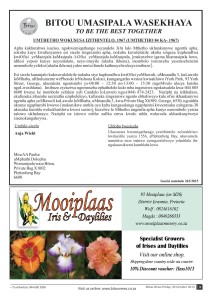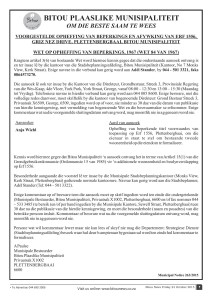Municipal
U3A
Monday 2nd November 2015
David Attenborough DVD : Amber
The fossilized tree gum that holds small
creatures perfectly preserved within itself
10H00 in Formosa Garden Village Lounge
Contact : Marina Niven 044-533-2699
Tuesday 3rd November 2015
Italian Conversation
10H00 at 12 Challenge Drive
Contact : Brenda Hardy 044-533-5489
Wednesday 4th November 2015
Medical Matters : Euthanasia
Dr Clive Noble will speak on this very sensitive subject,
how the different types affects our lives and apply in SA law
10H00 in Formosa Garden Village Lounge
Contact : Christo Vlok 044-533-5155
Friday 6th November 2015
Tai Chi Class for U3A members
09H00 to 09H45 at St Peter’s Church Hall
Contact : Jennie Anderson 044-533-0089
Friday 6th November 2015
French Conversation
10H30 at 7 Glennifer Street
Contact : Merle Decot 044-533-5879
Friday 6th November 2015
Mah Jong : Ancient Game
13H30 in FGV Small Dining Room
Contact : Amelia White 044-533-0113
11 Dog Cookie Recipes for Extra Good Doggies

If your dog has been extra good, why not treat him to one of these 11 dog cookie recipes? Made with love from you to your smiling pooch.
For extra good doggies, here are 11 dog cookie recipes that will make them lick their jowls! Your best friend deserves a special treat, so why not whip up a batch of homemade dog cookies? You’ll know what’s in them, and you can cater to any picky or allergy-prone pooch. With ingredients you already have in your kitchen, like whole wheat flour, oats and peanut butter, you can make your doggie her own batch of cookies.
For dogs who are allergic to wheat, there are also good wheat-free alternatives. Drop cookies, rolled cookies, pumpkin, carob and bacon — you’ll find something to please your pooch.
Here are 11 dog cookie recipes to get you started:
Pumpkin, Peanut Butter and Bacon Dog Cookies
Make these cookies from Seattle Palate using pumpkin for fiber, and the most tasty doggie combination of flavors — peanut butter and bacon! Think about making an extra batch, too. Your pup won’t be able to keep his paws out of the cookie jar!
Classic Carob Chip Cookies
Try this recipe from Minnie in Manhattan. Since chocolate can be toxic to dogs, this cookie is loaded with carob chips instead. It looks just like a classic chocolate chip cookie, but it’s for your good doggie to enjoy!
dog cookie recipes
Calvin’s Christmas Cookies
If your little boy or girl’s been good all year, cook up a batch of these festive-looking treats from The Scrumptious Pumpkin. With ingredients like honey, dried cranberries and pumpkin seeds, these almost sound good enough to leave for Santa!
Twist n’ Licks
These sweet treats from My Dog’s Breakfast resemble everyone’s favorite cream-filled cookie but taste like carob and peanut butter. Use a wheat-free flour if you’re worried about allergies, and make the middle with plain Greek yogurt and peanut butter for a dose of healthy protein.
Grain-Free Homemade Carrot and Banana Dog Cookies
Who says healthy can’t mean yummy, too? Make these grain-free goodies from K9 Instinct for your furry friends.
Gluten-Free Canine Cookies
Whip up a batch of these gluten-free cookies from Whole Lifestyle Nutrition with pumpkin, brown rice flour and organic milk in just under an hour.
Peanut Butter and Honey Roll-up Dog Cookies
Why not whip up a batch of these roll-up cookies from All Natural Dog Treat when your little gal is being extra good? With two layers of healthy ingredients, you’ll love making these for those special reward times.
Veggie Chip Cookies
Try this cookie recipe from My Dog’s Breakfast to give your dog a treat and an extra serving of veggies, too!
dog cookie recipes
Peanut Butter and Apple Sauce Cookies
Why not make these yummy doggie cookies from The Lazy Pitbull? Mix up a batch of these tasty, wholesome snacks and cut them into your favorite shapes — your little pooch will be barking for more in no time!
dog cookie recipes
Apple Peanut Butter Doggie Cookies
Make a great dog cookie dough with this recipe from Cookie Dough and Oven Mitt and cut it into your pup’s favorite festive shape! With eggs, whole wheat flour, honey, apple sauce and peanut butter, this dough is super easy to work with. Try making some for a special occasion (hearts for Valentine’s Day, anyone?) so everyone in your family gets a special treat!
dog cookie recipes
Chick N’ Spinach Cookies
What pup wouldn’t love these savory cookies from Bunny Roo Beagle? With shredded chicken and spinach, they look festive but taste like a special meal. No need to wait for the next St. Patrick’s Day to make these. Your dog will love them all year round!
for all recipes visit :
-petcare.com
GUARDING YOUR INTELLECTUAL PROPERTY

Theft of confidential information and trade secrets can be just as damaging to your business as embezzlement or other employee fraud. Help protect your competitive advantage with these tips:
Buy paper shredders … and use them: Putting unshredded copies of sensitive or confidential documents in the garbage opens up a range of security issues.
Have a plan for terminated employees:
Don’t let a disgruntled ex-employee become a security threat. Have a plan in place to keep a person from leaving your company with confidential documents. Some steps to follow include:
Where there is a high risk, have the person leave the company immediately upon termination.
Make arrangements for the immediate return of keys and any confidential company information.
Remove the person’s password from your computer network immediately.
Use computer passwords:
Require your employees to use passwords to access your computers or your network. This will serve to keep unauthorised people away from important files.
Have all employees sign non-disclosure agreements:
Make sure employees understand that theft of intellectual property is as serious to your business as theft of physical property. Use a non-disclosure agreement or a non-disclosure clause in an employment contract, to spell out employees’ responsibilities regarding confidential or trade secret information. Be sure you define what your company considers to be confidential. This is critical, since it clearly differentiates which information belongs to your company and which belongs to the ex-employee. The agreement also should outline steps the employee must take to maintain confidentiality, such as using computer passwords, not removing sales lists from premises, not copying documents to disk etc.
Keep tabs on your documents:
Set and enforce strict procedures for access to confidential or trade secret information. Allow only those who need certain information to see it.
Label key electronic documents (such as your customer database) as “read only” or password lock the documents so they cannot be altered or written to disk.
Don’t tempt prying eyes:
Don’t make it easy for people who aren’t supposed to see confidential documents to snoop. Never leave documents lying around. File things away when you’re done with them or when you’re away from your desk. Lock your filing cabinet and your desk drawer when you’re away. Close computer files when they are not being used and never leave a file on your screen when you go away from your desk.
(Henry Grobler 044 873 6112) •
More colourful Plett gardens for PAWS

Garden lovers can look forward to the fourth Plett Open Garden Day in support of PAWS, on Saturday 31 October from 10:00 to 16:00. This popular event will again feature Rae Gilbert’s magnificent Bosky Dell Rose Garden as the anchor garden. Last year, despite cold and wet weather, 313 hardy visitors turned up to help PAWS raise the impressive sum of R34 000.
The roses at Bosky Dell will show off their first glorious flush of colour and visitors can enjoy the tea garden, PAWS quality cake and plant sales – with live music thrown in.
Tickets at R60 for all four gardens will be sold at all the gardens. Flyers describing the gardens and their locations will be available at all the gardens, and can be collected from Barney’s Kiosk, next to Mugg and Bean, in the Market Square Shopping Centre.
Plett GardensThe small, but committed PAWS team works hard to raise enough funds to cover our monthly operating costs of about R50 000. Without the generous support of the public for our events,, we cannot continue to provide the essential primary health care service, to improve living conditions for the many neglected and abused dogs and cats in the Bitou region.
The featured gardens are:
Bosky-Dell Rose Garden. Access on the N2, opposite The Heath – follow dirt road to the farm. This magnificent rose garden, containing more than 6 000 rose bushes, is based on strict geometric design, with the bright colours of a large variety of roses complemented by indigenous borders and shrubs. A central pavilion, overlooking a verdant valley, houses the tea garden and visitors can stroll around a lovely lily pond.
Plett GardensHawkes garden. Brackenridge Estate, access via main entrance, off Piesang Valley Road. Directions available at gate. The position of the stand, at the top of the ridge and exposed to prevailing wind was an important factor when planning the garden. Mike Vlok, the designer of this impressive indigenous garden, over two stands, created several tranquil corners, including a pond with a Robbie Leggatt sculpture. The plan includes imaginative planting of some exotics to provide year-round colour.
McIvor garden. 52 Bitou Glade, access via main entrance to Brackenridge Estate, off Piesang Valley. Directions available at gate. Designing this indigenous garden was quite a challenge because of severe clay conditions. Graham von Hoesslin provided the backbone for the layout, and the owner set about planting her garden for the bees, birds, butterflies and buck. She has had to learn to share her garden with many wild visitors, including a voracious tortoise who loves gazanias.
Plett GardensDippenaar garden. 4 Robbebergbaai Road, Brakkloof, Last road left, off the road leading to Robberg Nature Reserve gate. This garden was very new when it was featured during the first Open Garden Day in 2012. Now, three years later, it has matured and still offers a large variety of mainly indigenous plants, with natural and unstructured plantings . It was designed for maximum impact of colour and to attract nectar, fruit and insect-eating birds.
For more information contact Marsja Hall-Green: 073 645 9476/044 533 4578•
Seeff Edition 45
Municipal
The Benefits of Music for Cats

Does your cat disapprove of your taste in music? There’s a reason for that! Research shows that cats are more likely to be interested in cat music than human music, says Charles T. Snowdon, a Hilldale Professor Emeritus in the department of psychology at the University of Wisconsin-Madison, and the lead author of the study, “Cats Prefer Species-Appropriate Music.”
Didn’t think that music for cats existed? Think again! Cats, with their acute sense of hearing, instinctively prefer music that corresponds closely with the sounds they use to communicate with each other, such as purring and meowing. So there’s no need to take it personally if your cat snubs your favorite tune or leaves the room when you cue up your stereo! It’s not because of her discerning taste — she just may not be able to tolerate the tone and volume.
How Can You Use Music With Your Cats?
Like humans, cats do enjoy listening to music. But they prefer music that’s chosen with them in mind, especially classical music. “I believe they respond well both to music for calming and enrichment,” says Dr. Susan Wagner, an integrative medicine doctor at MedVet Columbus and an adjunct assistant professor at The Ohio State University College of Veterinary Medicine.
Dr. Wagner, who specializes in music therapy for animals, recommends two types of music for cats: calming (to reduce stress) and enriching (to stimulate). “Calming music has lower tones, slower tempos and minimal instrumentation, while enriching music is just the opposite,” she says. For example, a soothing Chopin piano sonata calms your kitty down, while a lively Bach flute sonata encourages her to jump and play.
Do you like to leave the radio on when you’re out of the house as a way to keep your cat company? If so, it’s important for you to choose the music that you play wisely, as it has the potential to do more harm than good. According to Snowdon, you must be sure to avoid any music that may induce negative emotions in your furry companion.
What Are the Benefits of Music for Cats?
There are many benefits of introducing your cat to the world of music. According to Dr. Wagner, you should play calming music for at least an hour a day if your pet tends to be anxious or scared. And “enriching music is especially wonderful for indoor cats,” she adds.
According to Dr. Wagner, music therapy can be used to help cats who are suffering from a variety of serious medical conditions. “I have recommended music for my feline patients who suffer from anxiety or disorders that are exacerbated by anxiety, such as Feline Interstitial Cystitis, Herpes or Inflammatory Bowel Disease,” she says. “I also have found it helpful in any chronic condition that creates stress, whether it is osteoarthritis, diabetes or cancer.”
According to Snowdon, music also does wonders for feral cats. “One of the main benefits of the cat music may be to help animals that have previously been abused or neglected to develop confidence in their new human companions,” he says. For instance, this music may urge an unresponsive stray cat to approach and interact with a new owner.
Ideally, you and your kitty can come to a mutual agreement on what type of music to play in your home. “There needs to be a balance between music for humans and for cats when both are together,” says Snowdon.
-petcare.com
LEARNERS AND STUDENTS
EXAMINATION TIME: CONSOLIDATE AND ACHIEVE – Part 2
The “science of learning”. In the previous edition of the Mossview, Prof Gous highlighted the first 5 of 10 basic principles of learning….
Attitude and Interest
Motivation
Anxiety
Time Management
Concentration and Attention
INFORMATION PROCESSING,
acquiring the knowledge, and reasoning.
Assimilation of study material means more than just learning. It involves identifying, understanding and applying the principles of the subject. Before the exams every student should be able to make a list of all the principles in a course. If this is not possible you should scan the study material immediately, review all applications, examples, problems, typical questions and previous exam papers if possible. Also check to ascertain whether they illustrate in any way the principles. The latter is particularly valuable in subjects which can be defined as problem solving disciples eg. Maths and Science. It is much better to learning or acquiring knowledge that involves comprehension through the active reorganization of the material than to memorize merely for the exams. Students, who have analysed and evaluated the content of the study material for making useful summaries – a condensed form as a single source of study.
SELECTING MAIN IDEAS,
recognizing and relating important information.
Very few students pay sufficient attention to headings, sub-headings and summaries in their study material. They often memorise details without knowing how and where these facts fit into the structure of the course. It is advisable to establish a thorough understanding of the outline of the course, by memorizing headings and sub-headings when studying. This outline serves as a frame of reference within which details can be organized as reading and studying proceed. When reading you should always be aware of the development of the theme from paragraph to paragraph. A paragraph is usually built around one major idea. This idea is often stated in a sentence at the beginning, the middle or the end of the paragraph. It is also helpful to identify the key word(s) in a paragraph. They appear in topic or key sentences of paragraphs.
Use of SUPPORT TECHNIQUES and MATERIALS. Underlining and the making of summaries are useful when revising the study materials. Make drawings and sketches, simple charts, diagrams and tables to enable one to clarify and better understand the content. Visualisation and picturing can make the study material more concrete, definite and comprehensible. To visualize is to think with the mind’s eye; to conjure up pictures or images which may clarify abstract concepts. Compare notes with those of friends and participate in study groups.
SELFTESTING and REVIEWING – the latter the most important single element in an effective study system. The best time to review is immediately after completing a section of the study material. Reviewing involves testing oneself immediately after the reading. It compels one to interact with the study material and guarantees better comprehension and retention. Plodding through the material passively and focusing on underlined highlights is ineffective. In half an hour of hard work a student can achieve more than in a whole evening of lazy drudgery. Be actively involved during the process of reviewing. Create questions that might be included when preparing for the exams. Try to identify potential questions when reviewing study materials. And always test yourself to be sure you know the material you have been studying. Self-testing is an essential element in determining just how much is enough. It is important to be able to successfully recall material twice during testing and re-testing.
PREPARING and EXAMINATION STRATEGIES. Only a short period of time is available. Therefore time management must be well structured and materials accordingly organized e.g. Summaries of summaries – the keys to all the information. It is important to consolidate the knowledge that one has built up over the past few months. Attend carefully to the instructions before starting on an examination by reading instructions and questions. The outlines serve as memory aids and are extended by adding details recalled during the course of the examination. All writing should be done in the answer books. Answer the questions which you feel most confident about first, if no specific order for answering questions is required. Identify each answer clearly with the appropriate question number.
Prof Hendrik Gous –
044 695 0841/081 270 4227 •









